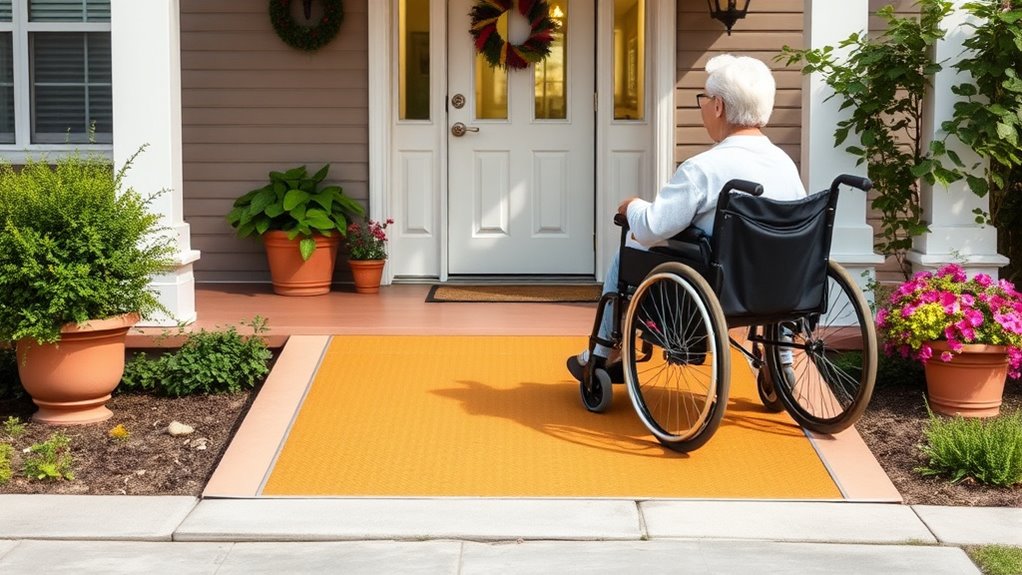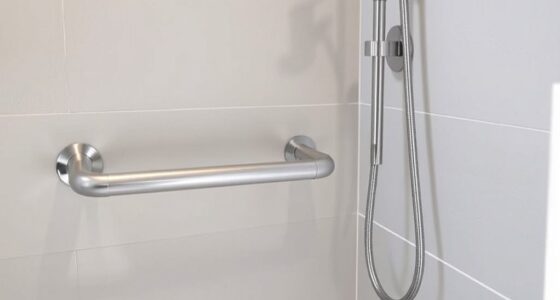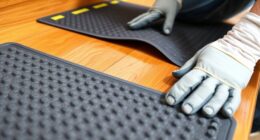To make your home entrance wheelchair accessible for seniors, install a smooth, gentle ramp with a 1:12 slope ratio and non-slip surface. Widen doorways to at least 36 inches and choose door handles that are easy to operate. Add proper lighting and handrails for added safety, and guarantee thresholds are low or flush to prevent tripping. Consulting a professional can help you design the safest, most functional solution—if you explore further, you’ll discover how to create a truly accessible entryway.
Key Takeaways
- Install gentle, non-slip ramps with a 1:12 slope ratio for smooth wheelchair access.
- Widen doorways to at least 36 inches and add low or flush thresholds for easier passage.
- Incorporate proper lighting, accessible door handles, and handrails to enhance safety and support.
- Use vertical storage solutions and keep pathways clear to prevent obstacles and improve navigation.
- Consult home accessibility specialists to ensure modifications meet safety standards and future needs.

Creating a wheelchair-accessible home entrance is vital for seniors to maintain independence and safety. When designing or modifying your entryway, consider implementing adaptive ramps. Unlike traditional steps, adaptive ramps provide a smooth, gradual incline that allows wheelchair users to enter and exit comfortably without assistance. You should aim for a gentle slope—generally a 1:12 ratio, meaning for every inch of height, there should be at least one foot of ramp length. This setup minimizes the risk of tipping or falling and makes navigation safer. Choose durable, non-slip materials for the ramp surface to prevent accidents, especially in wet conditions. You can also opt for modular ramps, which are easier to install and remove if needed, offering flexibility for future modifications.
In addition to ramps, doorway widening plays a vital role in ensuring easy access. Standard doorways are often too narrow for wheelchair clearance, typically measuring 24 to 30 inches wide. Widening the doorway to at least 36 inches creates enough space for a wheelchair to pass through comfortably, aligning with accessibility standards. This process might involve removing or modifying door frames or walls, so consulting with a professional guarantees the job is done correctly and safely. When enlarging the doorway, consider the threshold as well; a low or flush threshold is preferable to prevent tripping or difficulty crossing from one surface to another. Installing a swing-clear or pocket door can also save space and improve maneuverability, making it easier for seniors to enter and exit without hassle. Additionally, incorporating vertical storage solutions near the entrance can help keep mobility pathways clear of clutter, promoting safety and organization. Incorporating proper lighting is also essential to improve visibility and prevent accidents during entry and exit, especially at night. An often-overlooked aspect is door handle accessibility, which should be easy to grasp and operate for those with limited hand strength. To further enhance safety and convenience, adding handrails along ramps and near doorways provides extra support for those with limited mobility, reducing fall risks. Furthermore, consulting with home accessibility specialists can ensure that all modifications meet current safety standards and are tailored to individual needs, ultimately promoting greater independence and confidence for seniors.
Frequently Asked Questions
What Are the Costs Associated With Installing Wheelchair Ramps?
When considering the cost estimation for installing wheelchair ramps, you’ll want to look at material options like aluminum, wood, or steel, which affect the overall price. The costs can range from $300 to over $1,500 depending on length, complexity, and labor. You should also factor in potential customization needs. By comparing these material options and evaluating your specific entrance, you can better plan your budget for a safe, accessible solution.
How Long Does It Typically Take to Complete Modifications?
You might think the installation timeline for modifications takes forever, but it usually doesn’t. Typically, project planning helps you understand that most wheelchair ramp installations are done within a day or two. Factors like the complexity of the project and weather can influence the timeline, but overall, you can expect swift progress. You’ll be able to plan comfortably, knowing most modifications won’t keep you waiting for weeks on end.
Are There Government Grants or Financial Assistance Programs Available?
You might be pleased to know that there are government grants and financial aid programs available for home modification projects. These programs are designed to help you cover the costs of making your home more accessible, especially if you’re a senior or have mobility challenges. To find the right assistance, you should explore local, state, or federal programs that offer financial aid for home modifications. This support can make your project more affordable and achievable.
Can Existing Stairs Be Converted Into Wheelchair-Accessible Ramps?
You can convert existing stairs into wheelchair-accessible ramps through staircase redesign. First, assess the space and slope requirements. Then, choose suitable ramp material choices like durable wood, metal, or composite for safety and longevity. A professional can help guarantee the redesign meets ADA standards. This way, you create a smooth, secure passage that improves accessibility without major structural changes.
What Safety Features Should Be Added to Enhance Accessibility?
Think of your home entrance as a bridge connecting safe passage to comfort. To reinforce this connection, add essential safety features like sturdy handrail installation and non-slip surfaces. These elements act as guardrails, guiding and protecting you. They ensure stability and prevent slips, making the journey easier and safer. By incorporating these features, you create a welcoming, secure gateway that invites independence and peace of mind.
Conclusion
By making your home entrances wheelchair accessible, you’re creating a safer, more inclusive environment. You’re removing barriers, opening doors, and welcoming independence. You’re ensuring comfort, fostering confidence, and promoting peace of mind. With every step you take to improve accessibility, you’re not just modifying your home—you’re transforming it into a space where seniors can thrive, move freely, and feel truly at home. Because accessibility isn’t just about entry—it’s about embracing dignity, safety, and love.









